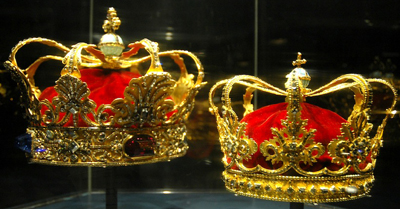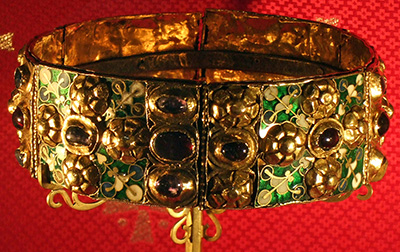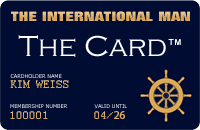Famous Royal and Imperial Crown Jewels and Regalia
CROWN JEWELS is the traditional English term for the elements in metalwork or jewellery of the royal regalia of a particular state. They are often only used for the coronation of a monarch and a few other ceremonial occasions, though the monarch may also be often shown wearing them in portraits, as they symbolize the power and continuity of the monarchy. Though additions to them may be made, since medieval times the existing items are typically passed down unchanged as they symbolize the continuity of the monarchy.
Typical items in Europe include crowns, sceptres, orbs, swords, rings, all usually in gold and heavily decorated with jewels, in styles which go back to the Middle Ages and are normally very conservative to emphasize the continuity of the monarchy. Many crown jewels are kept in a museum setting except when in use, and can be seen by the public. The crown jewels of many former monarchies can also be seen in museums, and may still represent national cultural icons even for countries that are now republics, as for example in Hungary, where the Holy Crown of Hungary has been re-incorporated in the coat of arms of Hungary. Several countries outside Europe have crown jewels that are either in traditional forms for the country, or a synthesis of European and local forms and styles.
- 10 most iconic jewels through history - "'Cursed' gemstones, beautiful emblems of famous love affairs, and symbols of dark histories - all these dazzling jewels have intriguing backstories, writes Daisy Woodward."
 - Bohemian crown jewels - also called the Czech crown jewels, include the Crown of Saint Wenceslas, the royal orb and sceptre, the coronation vestments of the Kings of Bohemia, the gold reliquary cross, and St. Wenceslas' sword.
- CROWN JEWELS - Wikipedia.
- Crown Jewels of Major Countries - "Royalty comes with lots of perks, among them access to crown jewels. If you thought that crown jewels were exclusive to Britain, you'd be wrong. Many other countries in Europe, and a few in other parts of the world, have some bejeweled swag as well. And even parts of the U.S. have crown jewels of their own."
- CROWN JEWELS OF THE BRITISH MONARCHS - "The Crown Jewels are displayed at the Jewel House in the Tower of London and can be viewed there by the public. The coronation of a new sovereign is one of the monarchy's most glittering pageants, staged in the gothic splendour of ancient Westminster Abbey, where every King and Queen of England, with the exception of Edward V and Edward VIII, has been crowned since King Harold II in 1066. This time-honoured ritual emphasizes the continuity and majesty of the British monarchy."
 - Crown Jewels of the United Kingdom - "The Crown Jewels have been stored and displayed at the Tower of London since 1661, continuing a long tradition of storing precious objects here."
 - Danish Crown Regalia - "They consist of three crowns, a Sceptre (symbolizing supreme authority), Globus cruciger (an orb symbolizing the earthly realm surmounted by a cross), the Sword of state and an Ampulla (symbolizing anointing of monarchs). The Danish Royal Regalia are kept in the treasury at Rosenborg Castle. The oldest of these is Christian III's sword of state from 1551. They further include King Christian IV's diamond; pearl- and gold-embroidered saddles; objects carved from ivory and rock-crystal; lapidary pieces of precious stones, and brooches in the form of fantastic animals."
- Descendants of Italy’s last king attempt to reclaim crown jewels - "Bank of Italy took delivery of the jewels, comprising more than 6,000 diamonds and 2,000 pearls mounted on brooches and necklaces worn by various queens and princesses, on 5 June 1946, three days after Italians voted to abolish the monarchy and nine days before King Umberto II, who ruled for just 34 days, was banished into exile along with his male heirs."
- Disgraced art dealer's family returns rare royal jewels to Cambodia - "The crown jewels were among 77 pieces of centuries-old gold jewelry handed over by the family of Douglas Latchford, a British antiquities dealer and leading scholar on Khmer art who in 2019 was accused by US authorities of trafficking artifacts looted from Cambodia."
 - FRENCH CROWN JEWELS - "Comprise the crowns, orb, sceptres, diadems and jewels that were symbols of Royal power between 752 and 1825. These were worn by many Kings and Queens of France as well as Emperor Napoleon. The set was finally broken up, with most of it sold off in 1885 by the Third Republic."
 - French Crown Jewels - "Their Sale and Dispersion."
- Gorgeous Emerald Tiaras - The Court Jeweller.
- Imperial Crown of Mexico - "The crown created for the Emperor of Mexico on two occasions. "
 - Imperial Crown of Russia - "Was used by the monarchs of Russia from 1762 until the Russian monarchy's abolition in 1917. The Great Imperial Crown was first used in a coronation by Catherine the Great, and it was last worn at the coronation of Nicholas II. It was displayed prominently next to Nicholas II on a cushion at the State Opening of the Russian Duma inside the Winter Palace in St. Petersburg in 1906. It survived the 1917 revolution and is currently on display in Moscow at the Kremlin Armoury's State Diamond Fund."
- India to Seek Return of Koh-i-Noor Diamond From Britain - "The Indian government has begun a campaign for the return of a historic 105.6-carat diamond that was either a gift to Queen Victoria from the maharajah of Punjab in 1849 or stolen by the British, depending on some widely divergent perspectives."
- ‘Inevitable’ India’s jewels taken by British empire will be returned, says author - "Narendra Modi is preparing a campaign to reclaim items in UK museums and held by the royal family, such as the Koh-i-noor. 'Our museums and the royal family are in possession of billions of pounds worth of Indian loot. It was a systematic part of colonial rule. The royal family was given the king’s share of that loot.'"
 - Iranian Crown Jewels - "Include elaborate crowns, thirty tiaras, and numerous aigrettes, a dozen bejeweled swords and shields, a number of unset precious gems, numerous plates and other dining services cast in precious metals and encrusted with gems, and several other more unusual items (such as a large golden globe with the oceans made of emeralds) collected or worn by the Persian monarchs from the 16th century (Safavid Persia) and on. The collection is housed at the Treasury of National Jewels, situated inside the Central Bank of Iran on Tehran's Ferdowsi Avenue."
 - Iron Crown of Lombardy - "A reliquary and may be one of the oldest royal insignia of Christendom. It was made in the Early Middle Ages, consisting of a circlet of gold and jewels fitted around a central silver band, which tradition held to be made of iron beaten out of a nail of the True Cross. In the medieval Kingdom of Italy, the crown came to be seen as a relic from the Kingdom of the Lombards and was used as regalia for the coronation of the Holy Roman Emperors as kings of Italy. It is kept in the Cathedral of Monza."
- Italy's former royal family wants the crown jewels back - "The jewels were deposited in the Bank of Italy by a representative of the family on June 5, 1946 - three days after Italians voted in a referendum to remove the monarchy - to be kept at the disposal of 'whoever has the right.' The family now argues that it has a right to ownership."
- King Charles III Coronation: Priceless symbols that will be seen at King Charles III's coronation - "A visual guide to King Charles III’s coronation. From huge diamonds to ornate swords, these are the priceless symbols to know as Britain’s new monarch is crowned."
- King Charles III's Coronation Jewels Will Be Worth Nearly $4 Billion - "Charles will be decked out in nearly $4 billion (!!) of coronation regalia. Yes, billion, with a B. 'How could one man possibly wear that much jewelry?' you might ask. But the collection is comprised of the St. Edwards Crown, Sovereign's Ring, Imperial State Crown, Sovereign’s Sceptre with dove, Sovereign’s Sceptre with the cross, Sovereign’s Orb, Gold Ampulla, the Spurs, and the Sword of Offering, all littered with gem stones like diamonds, sapphires, rubies, and pearls."
- PRINCELY JEWELS FOR MONACO’S BIG 100TH BIRTHDAY CELEBRATIONS - The Court Jeweller.
- Regalia of the Russian tsars - "From the 13th to the 20th centuries of the history of Russia, are the insignia of tsars and emperors of Russia. Some of the artefacts were changed or substituted, the most radical change happened in the 18th century, when Peter the Great reformed the state and transitioned it to European-style monarchy."
- Royal treasures hidden since World War II recovered from cathedral - "Historical treasures hidden for decades have been uncovered in the crypts of a cathedral, with items including burial crowns and insignia belonging to Medieval European rulers. The cache from Vilnius Cathedral, in Lithuania, has not been seen since the outbreak of World War II in 1939, according to a press release from Go Vilnius tourism promotion agency on Wednesday."
 - Russian Crown Jewels - "The Great Imperial Crown was made by a skilled court jeweller Jeremia Posier for the Empress Catherine II the Great's Coronation in 1762. It has a traditional shape and is made up of the two open hemispheres divided by a foliate garland and fastened with a low hoop. The crown is set with 5,000 selected Indian diamonds (some Russian sources state this number as 4,836) and and number fine, large white pearls. The crown is also decorated with one of the seven historic stones of the Russia's Diamond Collection - a large precious red spinel weighing 398.72 carats which was brought to Russia by Nicholas Spafary, the Russian envoy to China from 1675 to 1678."
 - Swedish Crown Regalia - "The Swedish Regalia are the principal symbols of Sweden's form of government. The kingdom's main regalia are the sword, the crown, the sceptre, the orb and the key. Their symbolism was defined during King Erik XIV's coronation in 1561."
- The curious case of the Irish Crown Jewels - "The theft of the Irish Crown Jewels from Dublin Castle in 1907 was Ireland's most scandalous heist - and it remains unsolved to this day."
 - The Mysterious Disappearance Of The Russian Crown Jewels - "Tracking the Story of the Russian Crown Jewels."
- Treasury of National Jewels - "The background of National Jewels of Iran dates back to Safavid era in which it was decided that national jewels belong to National Treasury of government,i.e., apart from the personal properties of the sovereign. The valuable collections of this museum comprises of the pink colored diamond of Darya-ye-Noor (182 Carats), the Peacock Throne or Takhte ..."
|
|














